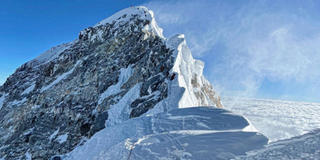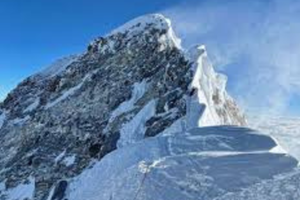
Mt Everest.
Since 1921 when the first attempt to summit the highest mountain in the world, Mt Everest was done, at least 330 climbers have died on the mountain. It is estimated that at least 200 bodies still lie on Mt Everest, uncollected or unfound.
Last year, at least 18 people died on Mt Everest, with 668 recorded summits in that year alone. At least 16 deaths were recorded in 2014, 11 in 2006 and 10 in 2012.
Between 1970 and 1979, at least 28 people died on Mount Everest, an increase of more than three times from six who died between 1960 and 1969. Between 1980 and 1989 at least 58 people died while 60 others died between 1990 and 1999.
The data shows that the number of deaths on the mountain will continue to increase as more people attempt to summit.
Min Bahadur Sherchan, a mountaineer from Nepal who died at 85 is the recorded oldest person who died on Mt Everest. He died at the base camp of the mountain in 2017 at the age of 85.
The Mountain was first scaled in 1953 (according to existing records) by New Zealander Sir Edmund Hillary and Sherpa Tenzing Norgay (a Nepalese-Indian). Since then, there have been at least 11,996 summits on Mount Everest.
Data shows that climbers who do not use supplemental oxygen (like in the case of Kenya’s Cheruiyot Kirui, who died on Thursday, May 23, 2024) have a three times more likelihood of dying.
Others who have died on Mt Everest include:
Alexander Mitchell Kellas was the first person to have died while attempting to climb Mount Everest in 1921. He was a British chemist, explorer, and mountaineer known for his studies of high-altitude physiology. He died of a heart attack alongside his porter who remains unknown.
In 2001, Babu Chiri Sherpa died from a fall near Camp II. He had climbed the mountain 10 times and spent 20 hours on the summit of Everest in 1999.
Another notable death is that of “Green boots”, the unidentified climber who is believed to be Tsewang Paljor and whose brightly coloured boots made him a landmark for those making an attempt to summit Mount Everest. The Indian national was among those who died in the 1996 season. The body was moved from the location in 2014.
David Sharp was an English mountaineer who died near the summit of Mount Everest in 2006. He died under the rocky overhang, sitting with arms clasped around his legs, next to Green Boots. His death caused controversy as other climbers were blamed for passing him without trying to help.
Francys Arsentiev was the first woman from the United States to reach the summit of Mount Everest without the aid of bottled oxygen but unfortunately died during descent in 1998. Her body remained visible to other climbers just like Green Boots and was named “Sleeping Beauty.”
Her body was eventually dropped from view in 2007.
Hannelore Schmatz was a German woman who died in 1979 during her descent from the summit. For many years her body was frozen in a sitting position, leaning against her backpack with eyes open and hair blowing in the wind. The wind eventually blew her remains over the edge of the mountain.
George Mallory was an English mountaineer who died in 1924 and was part of the first three British Mount Everest expeditions from the early to mid-1920s. George and his climbing partner Andrew Irvine were last seen 240 metres from the summit. George’s body was recovered in 1999.
Dan Fredinburg was an American who died in an avalanche at Mount Everest's Base Camp triggered by the April 2015 Nepal earthquake. He was among the 22 people who died that day. He was a Google executive who is believed to have climbed Everest with three company employees while mapping the area for a future Google Earth-type project.
Apart from Cheruiyot Kirui, there have been no other reports of Kenyans who have died while attempting to climb Mount Everest.








